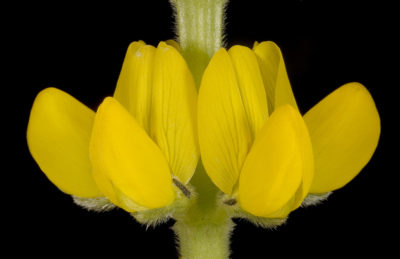
Yellow lupin - Photo by Cliff Hutson
Yellow lupin is often found growing as a wild plant in Mediterranean region. It is sometimes grown as a green manure. In the past, seeds were a common food in some Mediterranean countries, but nowadays they are just used as a pickled snack food.
Names
Scientific
Lupinus luteus
English
Annual yellow lupin
European yellow lupine
Yellow lupin
Dutch
Gele lupine
Spanish
Altramuz amarillo
French
Lupin jaune
German
Gelbe Lupine
Italian
Lupino giallo
Taxonomy
Genus
Lupinus
Family
Fabaceae
Order
Fabales
Basic information and facts
Origin:
Mediterranean region of Southern Europe.
Distribution:
Europe, Western Australia, South Africa
Annual, biennial, or perennial:
It’s an annual plant
Flowers:
A raceme with yellow flowers
Leaves:
hand-shaped leaves with 5 to 9 leaflets. Leaflets are 4 to 6 cm long and 1 to 3 cm wide.
Fruits:
Pods with yellow seeds, which are known as lupin beans.
Climate and weather:
Mediterranean and temperate climate
Height:
Plans are 30 to 60 cm tall
Propagation:
By seed
Uses:
Can be grown as a green manure. Seeds used to be used as food, but are now mainly used as snacks.
Crop categories
Food crops
Green manures
Legumes
Subtropical crops
Temperate crops
Pictures

Yellow lupin - Photo by Cliff Hutson

Yellow lupin pods- Photo by John Tann

Yellow lupin - Photo by Kevin Thiele

Yellow lupin - Photo by John Tann
